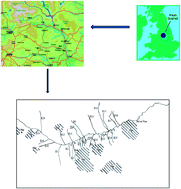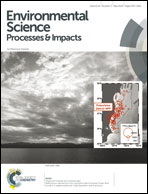Dispersion of U-series natural radionuclides in stream sediments from Edale, UK†
Abstract
The spatial distribution of 238U-series radionuclides, specifically 238U, 234U, 230Th and 226Ra, has been determined in stream sediments from Edale, Derbyshire, United Kingdom, to explore the behaviour of U-series radionuclides during weathering. For uranium and thorium, two different extraction methods were used, total dissolution with HNO3/HF in a microwave and leaching with aqua regia. This was followed by radiochemical separation using extraction chromatography, then alpha spectrometry measurement. The total radium contents in the sediments were measured using gamma spectrometry, while the leached fraction was measured in the same way as for uranium and thorium. The total sediment content of uranium and thorium ranges from ∼10 up to ∼200 Bq kg−1, while the radium specific activity lies between ∼15 and 180 Bq kg−1. In the aqua regia extractions, the uranium and thorium contents are in the range of ∼5 to ∼100 Bq kg−1, while the radium specific activities are similar to those measured by total dissolution. All the radionuclides show no correlation with organic matter content. The activity ratios 234U/238U, 230Th/238U and 226Ra/238U were used to determine the degree of radioactive disequilibrium. The data show disequilibrium in most of the sediments, with activity ratios of 234U/238U, 230Th/238U and 226Ra/238U > 1, inconsistent with evolution through straightforward weathering processes. Multivariate cluster analysis based on five variables, the specific activities of 238U, 234U, 230Th, 226Ra and loss on ignition, was employed to group the data and identify five distinct clusters. There seems to be a link between high radionuclide concentrations and proximity to landslips.


 Please wait while we load your content...
Please wait while we load your content...